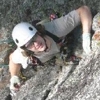i think stamp has a point
i mean, we all drive our cars to the crag, live in houses, buy from corporations and pave our driveways. after a long days work of contributing the depletion our resources and killing our planet we crack a beer, log onto our laptops and yell at our friends for a quarter kilogram of dust, or one 'key' crystal for a placement in a world that has much bigger problems. oh and, ' hey mother silly sally, i climbed this route using a #2 nut, what the frig are you thinking placing a #3 hex'? get off my (MY) route.
and why were at it that same arsehole who bolted lines at GZ left chalk all over the holds. what a pecker.
man this IS fun
New Aid line at Sorrows
Moderators: chossmonkey, Dom, granite_grrl, peter, Climb Nova Scotia, Matt Peck
41 posts
• Page 2 of 2 • 1, 2
Re: New Aid line at Sorrows
Scott.R
-

Scooter - Posts: 952
- Joined: Tue Dec 14, 2004 3:38 pm
- Location: Halifax, Nova Scotia
Re: New Aid line at Sorrows
Funny I agree. Its not as much of an environment issue as it is leaving the route as natural as we can so generations behind us can climb it, as it is, not as we manufactured it.
I wonder which is more mature discussing ethics on climbing or getting on a climbing chat site and start calling people names I wonder if the name calling happens in real life or just behind a computer screen?
I wonder if the name calling happens in real life or just behind a computer screen?
Mitt
I wonder which is more mature discussing ethics on climbing or getting on a climbing chat site and start calling people names
Mitt
-

The Mitt - Posts: 847
- Joined: Sun Dec 12, 2004 5:22 pm
- Location: Prospect NS
Re: New Aid line at Sorrows
To these boys, It happens in real life. 
-

Zamboni - Posts: 935
- Joined: Fri Oct 29, 2004 8:59 pm
- Location: Halifax
Re: New Aid line at Sorrows
scooter only agrees with stamp cause they're gargleing with each other's nuts.
maturity can take a running jump and go f--k its self.
any of you useless circle fisters climbing tommorow?
maturity can take a running jump and go f--k its self.
any of you useless circle fisters climbing tommorow?
- ben smith
- Posts: 508
- Joined: Fri Apr 15, 2005 7:03 pm
Re: New Aid line at Sorrows
I'm gonna dry tool over all y'alls trad, sport and aid lines
Yeeeeeeeeeeeeeeeeeehaaaaaaaaaaaawwwwwwwwwwww!
Bring on the Iceeeees!
Yeeeeeeeeeeeeeeeeeehaaaaaaaaaaaawwwwwwwwwwww!
Bring on the Iceeeees!
-

Eager - Posts: 190
- Joined: Sun Apr 17, 2005 9:53 pm
Re: New Aid line at Sorrows
I hate to be the spoil sport, but can you guys keep it reasonably clean?
If women ruled the world there would be no wars, just be a bunch of jealous countries not talking to each other.
-

chossmonkey - Posts: 1243
- Joined: Mon Nov 13, 2006 4:11 pm
- Location: Running a muck.
Re: New Aid line at Sorrows
Nate, thanks for clarifying your earlier report.
Sounds like some shiz-nit did make it onto Hesitation (!) - which I personally don't think is very cool. That route is a committing lead and the possibility of breaking the meager finger holds or the even meager-er protection opportunities seems to me to be quite thoughtless. [On par with dry-tooling established free climbs I would say]. What do the aiders (all 3 of you!!!) say to that?
S
Am I one of the three? What I say to that is if the hammer was not used it is clean aid. A hand placed piton is no different from any other passive protection. The fact that you could hit it with a hammer does not change this. You can hit a nut with a hammer to make it set better too. It is not the gear that determines if it is clean or not, it is how you use it. A hand placed tied off piton acts much like a tricam when placed in a horizontal crack.
Truly, I don't know what a "hand-placed pin" means to all people. Is it "hand placed" if your hand is on the end of a hammer? Why would you need to place a pin on a route that is lead with nuts - why not "hand place" a nut and high-step?
Hand-placed means no hammer was used. You slide a pin into a horizontal crack and it acts like a try cam. You weight the end of it and it pivots on the bottom lip of the crack while the end presses against the roof of the crack. This is clean and will hold for aid as long as you only pull down. Don’t pull out, because there is nothing holding it in the crack except for the leverage. I could bounce up and down on such a pin, and then remove it with my pinky finger once I had taken my wait off it.
Also, aid climbers normally have to make more placements than free climbers, which is part of the reason they climb so slow. I hope you found this post informative.
Nate, I might be interested in getting out on the rock with you next year. I did not climb this year, but I might be able to get out next year.
Teth
The Teth
-

The Teth - Posts: 453
- Joined: Wed Oct 27, 2004 1:01 pm
- Location: Halifax
Re: New Aid line at Sorrows
typically slow aid climber response teth-
haven't you realized that the boulderers, tards, and sportos have taken over this thread.
insults and immaturity only you pin placing, crystal chipping, hammer humping troglodyte
haven't you realized that the boulderers, tards, and sportos have taken over this thread.
insults and immaturity only you pin placing, crystal chipping, hammer humping troglodyte
- ben smith
- Posts: 508
- Joined: Fri Apr 15, 2005 7:03 pm
Re: New Aid line at Sorrows
It is nice to no longer be President, so you don’t have to hold it all in, eh Ben?
The Teth
-

The Teth - Posts: 453
- Joined: Wed Oct 27, 2004 1:01 pm
- Location: Halifax
Re: New Aid line at Sorrows
Oh come on chossmonkey, Mike hasn't even said anything yet!
-

Zamboni - Posts: 935
- Joined: Fri Oct 29, 2004 8:59 pm
- Location: Halifax
Re: New Aid line at Sorrows
I guess he should have got in when the getting was good.Zamboni wrote:Oh come on chossmonkey, Mike hasn't even said anything yet!
He can still post in here. Things where just starting to get a bit close to to much.
Then posts get deleted or altered and everyone gets upset. Nobody wants that do they?
If women ruled the world there would be no wars, just be a bunch of jealous countries not talking to each other.
-

chossmonkey - Posts: 1243
- Joined: Mon Nov 13, 2006 4:11 pm
- Location: Running a muck.
41 posts
• Page 2 of 2 • 1, 2
Who is online
Users browsing this forum: No registered users and 34 guests